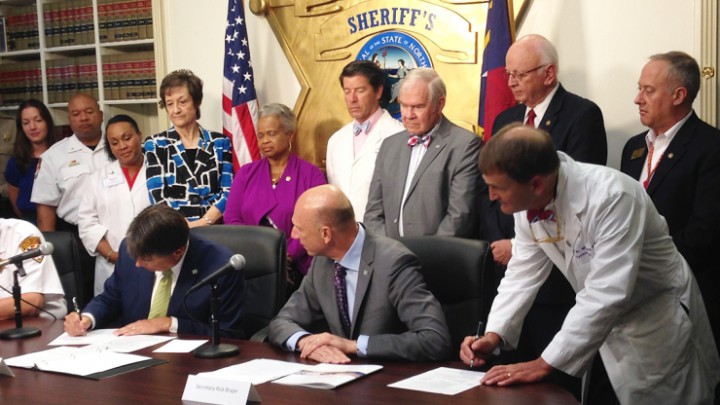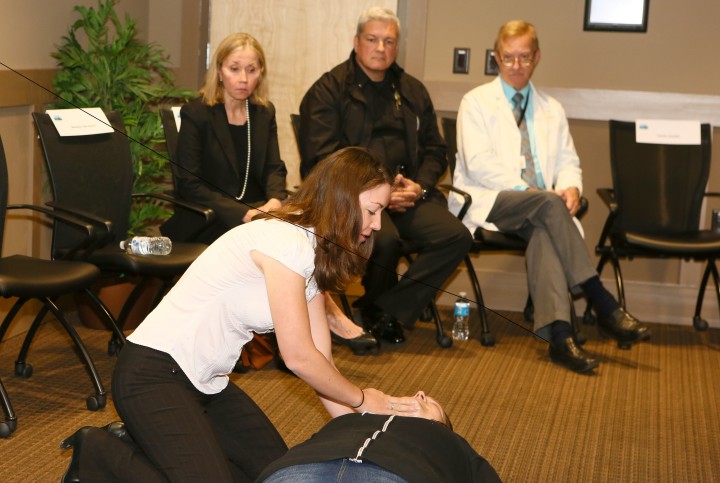A new state law increasing access to naloxone gives substance abusers a second chance to seek treatment for addiction.
“That time when your life is saved, literally saved, by this agent is a wonderful time for you to say, ‘Wow, what a wake-up call I just got. I’m motivated to get into treatment now,’” notes Brian Ingraham, CEO of the Smoky Mountain LME/MCO.
On June 20, Gov. Pat McCrory signed Senate Bill 734 into law at the Guilford County Sheriff’s Office. That enabled Dr. Randall Williams, the state health director, to sign a statewide standing order allowing wider access to naloxone, which can temporarily reverse drug overdoses. All N.C. pharmacies may now dispense the medication to anyone who requests it.
Ingraham, whom McCrory appointed to the N.C. Mental Health and Substance Abuse Task Force, says he fully supports the law. “We want people to have an opportunity for recovery: If you’re dead, you’re not going to be recovering.” Ingraham co-chairs the Workgroup on Prescription Opioid Abuse, Heroin Resurgence and Special Topics.
Spreading the news that naloxone is now more readily available is crucial, says Williams. “We’ve got to do a very purposeful job of letting people know that they have to go ask for it. The whole purpose of this bill is to eliminate all of those barriers if it’s going to save a life.”
In 2013, SB 20, the current law’s predecessor, launched the push to make naloxone more available. SB 20 granted immunity to people seeking medical assistance for a drug overdose, reducing illicit drug users’ fear of prosecution. The law also exempted pharmacies dispensing naloxone from criminal liability.
Naloxone temporarily staves off the respiration-arresting effects of an overdose of prescription opioid painkillers or heroin until medical assistance can arrive. The medication can be administered either as a nasal spray called Narcan or via an Evzio autoinjector.
Previously, pharmacists couldn’t dispense Narcan without a prescription, Nur Edwards of Asheville Discount Pharmacy explains. “With the standing order, I wouldn’t have to contact the physician. I could just determine that the individual could use naloxone. I should have it readily available, and I can dispense it. It’s kind of like a flu shot — there’s a standing order for pharmacists in North Carolina, and I can give you a flu shot without contacting your doctor.”

Some pharmacies in the state were already authorized to provide naloxone to anyone requesting it. “All the Rite Aids, for example, have a standing order for naloxone; they got that through our organization,” says Tessie Castillo, advocacy and communications coordinator at the North Carolina Harm Reduction Coalition.
Some emergency responders also carry Narcan. “There’s an EMS protocol,” notes Dr. Stace Horine, an emergency medicine physician at Mission Hospital. “All first responders in Buncombe and the surrounding areas can give intranasal Narcan.”
Williams says he often hears from law enforcement officers who revived someone using Narcan. “If you didn’t have that, he would be dead. You hear those stories and it’s very, very powerful.”
A prescription for addiction
Opioid pain medications, Horine stresses, have legitimate uses, but overprescribing and long-term use can lead to addiction. “A big part of it is the amount of prescriptions written by physicians,” he says. “If you have a painful problem, it’s perfectly appropriate to take pain medicine short term.”
Williams, however, says prescription opioids are gateway drugs that can lead to heroin use and potential overdoses. Worse yet, he adds, the extremely potent synthetic opioid fentanyl is being illicitly distributed as heroin. “In those cases, if you don’t have Narcan right there at the time, there’s no chance.”
Pain management clinics, says Edwards, occasionally provide a prescription for Narcan along with opioid painkillers as a safety measure. With elderly patients who may already have a respiratory illness, it’s especially important to proactively counter a potential medical emergency.
“I think it’s largely a liability issue, but it’s also a safety issue,” he points out, “because you have these 60-year-old patients that have been on pain medications their whole life. Their respiratory system is starting to slow down, and these opioids are contributing to that.”
Since 1999, the number of deaths from unintentional poisonings in North Carolina has increased 300 percent, according to data from the Injury and Violence Prevention branch of the state Department of Health and Human Services.
In 2014, more than 1,100 unintentional poisonings were reported. More than half (53 percent) were from prescription opioid painkillers, heroin or cocaine.
It usually isn’t necessary to prescribe Narcan along with prescription pain medications if they’re taken as directed, says Horine, but “overuse or not knowing what you’re taking” increases the risk of an overdose. In a pain management setting, he continues, a supplemental Narcan prescription may be appropriate.
Road to recovery

One potential downside of the law, cautions Horine, is that “If a family administers naloxone, or Narcan, the individual it’s given to responds and doesn’t seek medical help, and with longer-acting narcotics it may have a longer effect than the Narcan.”
Williams, meanwhile, stresses that once an overdose has been reversed, further intervention in a habitual drug abuser’s life is essential to ensure the greatest benefit. “We are under no illusion that this is a silver bullet,” he adds.
Smoky Mountain, a managed care organization that provides resources for treatment of mental health and substance abuse disorders to people on Medicaid and those without insurance, was instrumental in obtaining $100,000 worth of Narcan for distribution through the North Carolina Harm Reduction Coalition last year.
Not everyone favors easy access to naloxone, however. “The argument we hear against it is that if naloxone is more widely available, then drug users will use it as a plan B, or that it will make their behavior riskier, because they think they have a backup,” says Castillo.
A 2001 study of intravenous heroin users conducted at the University of California, San Francisco found no increase in overdoses six months after participating in an overdose prevention and management program utilizing naloxone, and heroin use was reduced. Results like these, Castillo maintains, fully support the overwhelmingly positive effects of increased access to the medication.
As soon as SB 20 became effective on Aug. 1, 2013, the Harm Reduction Coalition started its Overdose Prevention Project. Since then, more than 27,000 kits containing naloxone have been dispensed, and 3,235 lives are known to have been saved. Asheville alone accounted for 657 of those overdose reversals, giving hundreds of local people a chance to turn their lives around.
More and more in our culture, addiction is being seen as a disease rather than a destructive behavior that addicts can simply choose to stop.
“They can’t,” says Ingraham. “There are a lot of interventions that can occur for people that are life-changing, and you’ve got to be alive to have that happen for you.”



Before you comment
The comments section is here to provide a platform for civil dialogue on the issues we face together as a local community. Xpress is committed to offering this platform for all voices, but when the tone of the discussion gets nasty or strays off topic, we believe many people choose not to participate. Xpress editors are determined to moderate comments to ensure a constructive interchange is maintained. All comments judged not to be in keeping with the spirit of civil discourse will be removed and repeat violators will be banned. See here for our terms of service. Thank you for being part of this effort to promote respectful discussion.